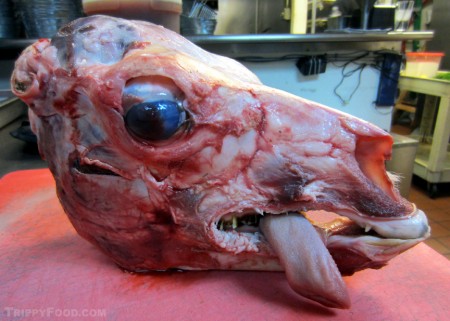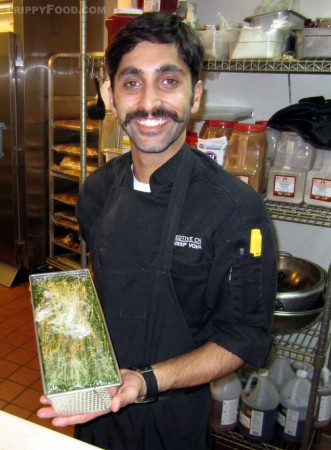Alpaca head cheese
Kings Row Gastropub, Pasadena, California
Connoisseurs of the meat dish with a dairy name have elevated what was once a butcher’s way to sell undesirable bits and pieces of the hog into a carnivorous foodie’s go-to charcuterie offering. Head cheese incorporates the fleshy parts of the pig’s head into a gelatin suspension created from collagen in the bones as the head is cooked down. Many chefs famous for their charcuterie will feature a house-made head cheese on their carving boards, although for those who have access to the heads and a few days on their hands, making head cheese is something even a home cook can create with relative success.
Since on a basic level, head cheese is made from an edible animal’s head, one can forego the dish’s porcine requirement and substitute to their heart’s delight; just keep in mind that it’s not quite as simple as boiling a head and then pouring the resulting soup into a terrine. To make your Noah’s ark head cheese product a success, we have created a video featuring Executive Chef Sundeep “Sunny” Vohra of Kings Row Gastropub creating head cheese using alpaca heads provided by Exotic Meat Market. Although the audio quality is inconsistent, you can follow Chef Vohra’s instruction using the recipe provided below. Whether you choose to replicate Sunny’s alpaca head cheese, or an animal of your own choosing, there’s no better way to embrace the nose-to-tail philosophy in ensuring that no part of the beast goes to waste.
Happy head hunting, and please let us know how it works out (unless you can convince Chef Vohra to add the alpaca head cheese to his menu)!
Recipe: Alpaca Head Cheese
Ingredients
30 lb. Alpaca head (brain and eyeballs removed)
4 ea. Smoked hog trotters
6 gal. Simple brine (recipe follows)
2 gal. ice water
4 oz. TCM #1
6 sprigs rosemary
2 ea. onion, quartered
1 oz. garlic cloves, whole
8 ea. Bay leaf
4 ea. juniper berries
4 tbsp. black peppercorns
1 tbsp. white peppercorns
1 stick cinnamon
2 ea. lemon
1 ea. celery stalk
2 ea. carrot
2 bunch parsley
3 oz. cranberries
3 oz. walnuts
Simple Brine
6 gal. water
6 cupa Kosher salt
3 cups sugar
Procedures
1. Prepare brine by adding water, salt, and sugar. Add in bay leaf, juniper berries, both peppercorns, cinnamon, 1 ea. lemon (zested and juiced), 1 bunch parsley, and half the garlic cloves. Place on stove and bring to a boil, then reduce to a simmer to dissolve the salt and sugar. Remove from heat and add in 2 gallons of ice water. Place brine in refrigerator overnight for flavors to come together.
2. Remove brine from refrigerator and let come to room temperature. Add in TCM #1, and stir and completely dissolve. Add in all of the alpaca heads, making sure all are submerged. Use a weight if needed. Place in refrigerator overnight.
3. Remove alpaca heads from brine solution, and rinse thoroughly. Discard the brine. Slice a piece of meat and cook to check salt content. If too salty, continue to rinse under water to desired salt content.
4. In large stock pot, add all the alpaca heads along with the rest of the garlic, onions, celery, carrot, rosemary, and smoked trotters. Fill with water to cover. Bring a boil then reduce to a gentle simmer, not to exceed 200F, skimming continuously over the next 5-6 hours or until the meat is tender. If Jaw detaches easily, it is ready.
6. When done, remove heads and trotters from stock pot and set aside to cool down. Strain the liquid through a fine sieve with cheesecloth. Skim and remove all fat as necessary. Return to the stock pot and reduce to form a nice gelatinous liquid. Test seasonings, and adjust if necessary.
7. In the meantime, zest 1 ea. lemon and blanch. Cut carrot into brunoise-sized pieces and blanch. Mince 1 bunch parsley. Set all to the side.
8. Test gelatin and flavor. If liquid is not gelatinous enough, continue to reduce to desired consistency. The gel should be sliceable, but not rubbery.
9. Begin to remove all the meat from the alpaca heads and smoked trotters and set to the side. Keep in mind to try to keep meat intact as much as possible.
10. Line terrine mold with plastic wrap. In layers, add in pieces of meat along with lemon zest, carrot, parsley, cranberries, and walnuts. Pour gelatin stock over the meat to fill in the air pockets and cracks between the ingredients. Fold plastic wrap over, and place a weight on top. Place in refrigerator to set over night. Can hold up to a week.
Pair with Avec les Bons Voeux (Best Wishes) beer from Belgium’s Brasserie Dupont brewery
Kings Row Gastropub
20 E Colorado Boulevard
Pasadena, CA 91103
GPS Coordinates: 34° 8’43.80″N 118° 8’59.93″W
Exotic Meat Market
130 West Walnut Street, Unit A5
Perris, CA 92571
GPS Coordinates: 33°49’36.71″N 117°13’44.83″W




